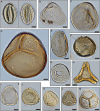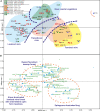Greenhouse conditions in lower Eocene coastal wetlands?-Lessons from Schöningen, Northern Germany
- PMID: 33439859
- PMCID: PMC7806146
- DOI: 10.1371/journal.pone.0232861
Greenhouse conditions in lower Eocene coastal wetlands?-Lessons from Schöningen, Northern Germany
Abstract
The Paleogene succession of the Helmstedt Lignite Mining District in Northern Germany includes coastal peat mire records from the latest Paleocene to the middle Eocene at the southern edge of the Proto-North Sea. Therefore, it covers the different long- and short-term climate perturbations of the Paleogene greenhouse. 56 samples from three individual sections of a lower Eocene seam in the record capture the typical succession of the vegetation in a coastal wetland during a period that was not affected by climate perturbation. This allows facies-dependent vegetational changes to be distinguished from those that were climate induced. Cluster analyses and NMDS of well-preserved palynomorph assemblages reveal four successional stages in the vegetation during peat accumulation: (1) a coastal vegetation, (2) an initial mire, (3) a transitional mire, and (4) a terminal mire. Biodiversity measures show that plant diversity decreased significantly in the successive stages. The highly diverse vegetation at the coast and in the adjacent initial mire was replaced by low diversity communities adapted to wet acidic environments and nutrient deficiency. The palynomorph assemblages are dominated by elements such as Alnus (Betulaceae) or Sphagnum (Sphagnaceae). Typical tropical elements which are characteristic for the middle Eocene part of the succession are missing. This indicates that a more warm-temperate climate prevailed in northwestern Germany during the early lower Eocene.
Conflict of interest statement
The authors have declared that no competing interests exist.
Figures















References
-
- Kennett JP, Stott LD. Abrupt deep-sea warming, palaeoceanographic changes and benthic extinctions at the end of the Palaeocene. Nature 1991; 353: 225–229.
-
- Röhl U, Bralower TJ, Norris RD, Wefer G. New chronology for the late Paleocene thermal maximum and its environmental implications. Geology 2000; 28: 927–930.
-
- Röhl U, Westerhold T, Bralower TJ, Zachos JC. On the duration of the Paleocene-Eocene thermal maximum (PETM). Geochemistry, Geophysics, Geosystems 2007; 8: Q12002 10.1029/2007GC001784, 2007. - DOI
Publication types
MeSH terms
Substances
LinkOut - more resources
Full Text Sources
Other Literature Sources

